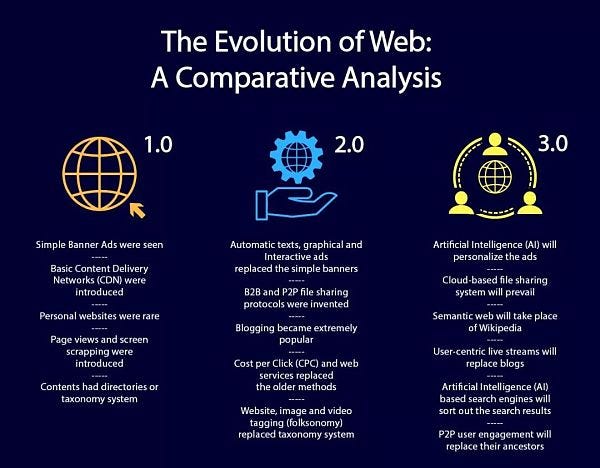The internet has come a long way since its inception in the 1980s. The first iteration of the web, Web 1.0, was a static, read-only version of the internet that provided users with basic information. The second iteration, Web 2.0, introduced interactivity and user-generated content, enabling users to contribute and collaborate with each other. Now, we are on the cusp of the third iteration, Web 3.0, which promises to be a truly decentralized, transparent, and secure version of the internet.
What is Web 3.0?

Web 3.0, also known as the decentralized web or the semantic web, is the next evolution of the internet that aims to enable a more open, collaborative, and secure online environment. At its core, Web 3.0 is characterized by three main features: decentralization, semantic web, and blockchain technology.
Decentralization
One of the key features of Web 3.0 is decentralization, which means that the internet will no longer be controlled by a few large corporations or organizations. Instead, it will be a distributed network of users and nodes, where everyone has equal access and control over the data and services they use. Decentralization will also ensure that data is stored in a distributed manner, making it more difficult for hackers to access or manipulate it.
Semantic Web
The semantic web is another important feature of Web 3.0. It refers to the ability of computers to understand and interpret the meaning of data, rather than simply storing and displaying it. This will enable machines to interpret information in a more human-like way, allowing for more intelligent and personalized online experiences.
Blockchain Technology
Blockchain technology, which is the backbone of cryptocurrencies like Bitcoin, is also a critical component of Web 3.0. Blockchain provides a secure and transparent way to record and transfer data, making it ideal for building decentralized applications and platforms. By using blockchain technology, Web 3.0 can ensure that data is stored and transmitted securely, without the need for centralized intermediaries.

What are the Benefits of Web 3.0?
The benefits of Web 3.0 are numerous and far-reaching. Here are some of the most significant advantages of the decentralized web:
1. Increased privacy and security: With Web 3.0, users can control their own data and protect their online privacy without the risk of centralized data breaches.
2 .More efficient and cost-effective transactions: Blockchain technology will enable more efficient and cost-effective transactions without the need for intermediaries.
3. Better user experience: The semantic web will enable more intelligent and personalized online experiences, providing users with more relevant and useful information.
4. Improved collaboration: Decentralization will enable greater collaboration between users and allow for more open and transparent sharing of information.
5. Empowering individual ownership: Web 3.0 will enable users to have greater ownership and control over their data, rather than being controlled by large corporations.
Examples of Web 3.0 Applications
While Web 3.0 is still in its early stages, there are already several exciting examples of its potential applications. Here are some of the most promising ones:
1. Decentralized social media: Platforms like Mastodon and Peepeth are decentralized social media platforms that are built on blockchain technology, allowing for greater privacy and control over data.
2. Decentralized marketplaces: Platforms like OpenBazaar and Origin Protocol are decentralized marketplaces that allow users to buy and sell goods and services without the need for intermediaries.
3. Decentralized finance: DeFi platforms like Uniswap and Aave are built on blockchain technology and allow for more efficient and cost-effective financial transactions.
4. Decentralized storage
Applications:
1. Decentralized file sharing: Platforms like IPFS (InterPlanetary File System) and BitTorrent enable users to share files in a decentralized manner, without relying on centralized servers.
2. Decentralized identity: Platforms like Civic and uPort use blockchain technology to provide users with decentralized identity verification and management.
3. Decentralized governance: DAOs (Decentralized Autonomous Organizations) are blockchain-based organizations that enable members to vote on decisions and manage funds in a decentralized manner.
4. Decentralized energy: Platforms like Power Ledger use blockchain technology to enable peer-to-peer energy trading, enabling users to buy and sell renewable energy directly to each other.
Challenges and Limitations
While Web 3.0 promises to be a more decentralized, transparent, and secure version of the internet, there are still several challenges and limitations that must be addressed. One of the biggest challenges is the need for mass adoption of decentralized technologies, which will require significant education and awareness efforts. Another challenge is the scalability of blockchain technology, which may need to be addressed to enable widespread adoption. Additionally, there are still legal and regulatory hurdles to overcome, as many governments have yet to fully understand and embrace the potential of Web 3.0.
Conclusion
Web 3.0 is the next evolution of the internet, and it promises to be a more decentralized, transparent, and secure version of the web. With features like decentralization, semantic web, and blockchain technology, Web 3.0 has the potential to provide a more efficient, collaborative, and personalized online experience. While there are still challenges and limitations to overcome, the potential benefits of Web 3.0 are significant, and it will be exciting to see how this technology develops in the years to come.

